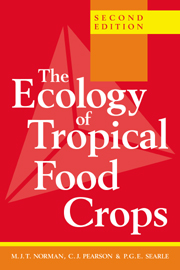15 - Cassava (Manihot esculenta)
Published online by Cambridge University Press: 05 June 2012
Summary
Taxonomy
The genus Manihot, which comprises a large number of ill-defined species, is of the family Euphorbiaceae. Rogers & Appan (1970), applying taximetric methods, classified the genus into 75 species. All have 36 chromosomes and all show regular bivalent pairing, but there is evidence of polyploidy (Jennings, 1976). Magoon, Krishnan & Bai (1969) suggest that Manihot species are segmental allotetraploids.
Cassava, Manihot esculenta, is not known in the wild state. It may be crossed with a number of Manihot species. Rogers & Appan (1970) nominate three groups, each with two to ten members, that are related to cassava. The closest relatives appear to be M. aesculifolia, M. rubricaulis and M. pringlei.
Purseglove (1968) distinguished cassava cultivars by two criteria: hydrocyanic acid (HCN) content and maturity time. On the basis of HCN, cultivars may broadly be divided into: sweet cassavas, of low HCN content, in which HCN is confined to the phelloderm of the tubers; and bitter cassavas, of high HCN content, in which HCN is usually distributed throughout the tuber. However, the distinction has no taxonomic basis (Nye, 1991). Levels of HCN do not correspond with any other known morphological or ecological feature, except for the very general relationship to maturity time given below.
On the basis of maturity, cultivars may be divided into:
Short-season types that mature in 6–11 months and which cannot be left in the ground for longer than 9–11 months without serious deterioration; these are often sweet cassavas.
[…]
- Type
- Chapter
- Information
- The Ecology of Tropical Food Crops , pp. 267 - 290Publisher: Cambridge University PressPrint publication year: 1995



